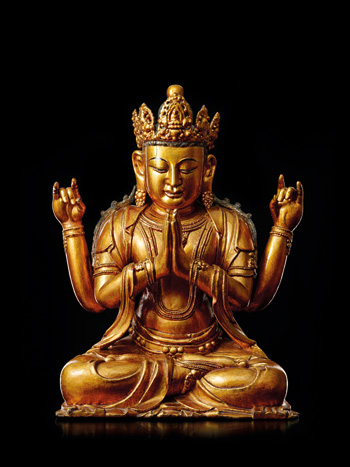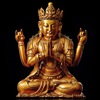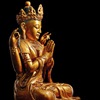The consecration cavity of the present lot contains three mustard seeds and a variety of documents, which were retrieved by Danielle Estienne, the Conservator supervised the Curator at the Musee d’Ethnologie de Geneve. The present lot contains one and a half Chinese pamphlets with text from the lotus sutra. One Chinese pamphlet with Daoist text originating from the Daharani of Immaculate Ushnisha. The partial fragments of a blue silk book cover bearing a title slip for a sutra of the Medicine Buddha and three rolled up tablets with a Chinese and Tibetan labels with both Chinese and Tibetan text written on the exterior. It contains seven pages of a mantra from the Dharani of Immaculate ushnisha and a single page with the Essence of Causation Mantra written in Tibetan. The four-armed Tantric image of the Bodhisattva Avalokitesvara is known as Sadaksari. The deity is often depicted holding a lotus spray and a garland of beads in the secondary hands. The four-armed Guanyin is also referred to as the liu zi Guanyin in reference to the six syllable Sanskrit mantra associated with Om mani padme hum. In retrospect, the imagery of the Sadaksara Guanyin first appeared during the Song dynasty. Gold-lacquered wood figure of Sadaksari Avalokitesvara attributed to the Ming dynasty are rare. For Sadaksari Avalokitesvara of a smaller scale constructed with a different medium of Gilt bronze from the Palace Museum in Beijing, illustrated in Treasures of the Palace Museum – Tibetan Buddhist sculpture, Hong Kong, p.167, p.177. Compare also with a Tibetan gilt bronze four arm figure of Avalokitesvara attributed to the 11th century from the Qing court collection, illustrated in The complete collection of treasures of the palace Museum, pl.50, p.51 and another dated to the 12th century, pl.114, p.119.
PROVENANCE: 1. Private Collection Switzerland, Acquired in the 1960s 2. Spink & Son Ltd., London



